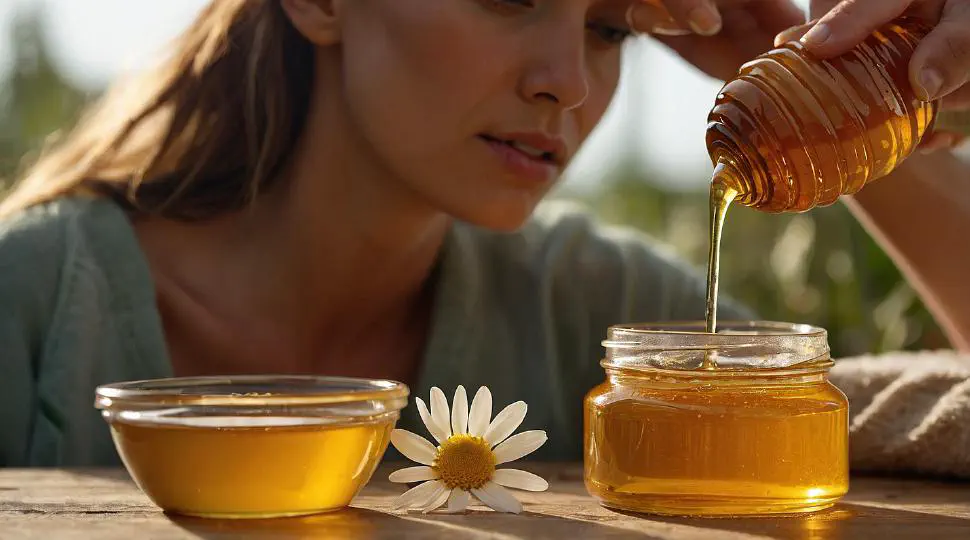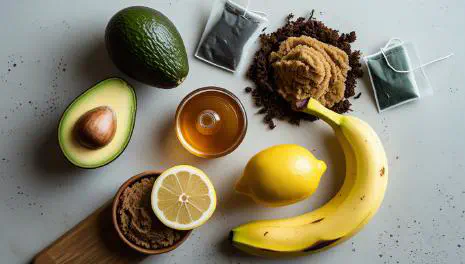Few natural substances have captured the imagination like honey, revered for millennia as a sweet treat and healing balm. This golden elixir is more than just a pantry staple; it’s a potent natural remedy with promising benefits for various skin conditions.
Honey is packed with beneficial components, including natural sugars, vitamins, and enzymes, bestowing it with remarkable antimicrobial and anti-inflammatory properties. Scientific studies shed light on its healing prowess, particularly in wound care and managing skin ailments like eczema.
In this article, we delve into the science behind honey’s therapeutic potential and explore its safe application in skincare regimes. From practical techniques to combining honey with other natural ingredients, discover how this age-old substance can be a modern ally in your skincare routine.
The Natural Composition of Honey: Key Components
Honey is more than just a sweetener; it’s a powerhouse of nutrients. Primarily composed of sugars, honey also contains amino acids, vitamins, and antioxidants. These components make honey a natural remedy for various ailments.
Key Components of Honey:
- Sugars: Mainly fructose and glucose, providing energy.
- Vitamins: Such as B vitamins, contributing to overall health.
- Amino Acids: Essential for protein synthesis.
- Antioxidants: Flavonoids and polyphenols help reduce inflammation.
Manuka honey stands out with its high concentration of minerals and bioactive compounds like Methyglyoxal, enhancing its antibacterial and anti-inflammatory properties. These attributes make Manuka honey a top choice for natural healing treatments.
For example, honey is often mixed with lemon to soothe sore throats. Its soothing properties are due to the natural compounds it contains. Below is a short comparison:
| Component | Manuka Honey | Regular Honey |
|---|---|---|
| Antioxidants | High | Moderate |
| Methyglyoxal | Present | Absent |
| Vitamins | High | Standard |
Honey’s composition makes it a versatile ingredient for home remedies, offering both health benefits and delicious flavor.
Antimicrobial Properties of Honey
Honey has been used for centuries, dating back to ancient Greek and Egyptian times, due to its impressive antimicrobial properties. This natural remedy is famous for treating skin infections and healing wounds. It contains natural compounds that help fend off harmful bacteria and promote healing.
Manuka honey stands out for its unique ability to combat methicillin-resistant Staphylococcus aureus (MRSA) by reducing its virulence, showcasing its antiviral potential. In addition, raw and unpasteurized honey has a low water content, which makes it effective against wild yeast and bacteria from the environment.
Recent studies show honey’s potential in reversing bacterial resistance. Its ability to work against bacteria is due to these antimicrobial properties. Many people are turning to honey as a home remedy during the cold and flu season, thanks to its broad medicinal potential.
Key Benefits of Honey:
- Antimicrobial and antiviral properties
- Helps with wound healing
- Potential to reverse bacterial resistance
- Effective against certain harmful bacteria and yeasts
Incorporating honey into your wellness routine could offer natural health benefits and boost your immune system.
Anti-Inflammatory Effects of Honey
Honey has been treasured for its health benefits for thousands of years. Ancient Greeks and Egyptians used it for its natural anti-inflammatory properties. Recent preclinical studies suggest honey could ease allergy symptoms, although more research is needed.
Here are some ways honey’s anti-inflammatory properties can be beneficial:
- Sore Throat Relief: Honey can soothe sore throats, making it useful in post-operative care, such as after tonsillectomies.
- Cold and Infection Support: When combined with cinnamon, honey’s anti-inflammatory capabilities can help fight infections and ease cold symptoms.
- Garlic and Honey: Both are rich in antioxidants and can reduce inflammation, supporting the body’s defense against chronic conditions and infections.
The combination of honey and garlic can be a powerful home remedy with potential immune-boosting and antibacterial properties.
| Ingredient | Benefits |
|---|---|
| Honey | Anti-inflammatory, sore throat relief, infection support |
| Garlic | Antioxidant-rich, fights infections, reduces inflammation |
Adding honey to your diet can be a natural remedy to help ease inflammation. However, always seek medical advice if you have concerns about its effects or interactions.
Honey for Wound Healing: Scientific Evidence
Honey has played a crucial role in the healing arts since ancient times. Greeks and Egyptians revered it for its ability to promote wound healing. Its natural antimicrobial and anti-inflammatory qualities make it a favorite in traditional medicine. One type, Manuka honey, stands out for its high methylglyoxal (MGO) content. This makes it especially effective against bacteria. Scientific studies show that honey not only speeds up wound healing but may also help reverse bacterial resistance. These features position honey as a promising treatment in wound care. Beyond its basic composition, honey’s antioxidants add another layer of health benefits. Modern science continues to explore how honey can support the immune system. It may even help control immune cells that become too active. This could further aid the healing of wounds, making honey a versatile remedy backed by both tradition and science.
In vivo Studies
Honey is often used to treat various skin conditions due to its antibacterial properties. It can effectively address skin issues such as acne and dryness. When applied correctly, honey acts as a gentle remedy with minimal side effects. Medical-grade honey is considered safe for skin application. To promote faster healing, it’s often layered on affected skin and covered with a sterile bandage overnight. Before using honey extensively, conduct a small patch test to check for allergies, especially if you have sensitivities to bees or pollen. Observations support honey’s antimicrobial characteristics. This makes it a viable treatment option, particularly for adults. Raw honey also brings a host of benefits. It is rich in essential enzymes, vitamins, minerals, antioxidants, and probiotics. These components contribute to honey’s effectiveness as a natural treatment, enhancing skin health and providing additional benefits in wound care.
Honey and Skin Conditions
Honey has long been known for its soothing and healing properties, especially in skin care. Applying medical-grade honey to damaged skin can help reduce the risk of infection due to its antibacterial properties. This makes honey an excellent remedy for skin irritations like allergic rashes and acne flare-ups. Medical-grade honey is often used in healing wounds, burns, and scratches. While various products claim to include pure honey for skin benefits, it’s essential to remember that these are not held to the same standards as medicines. Users should be cautious of contaminants like bee pollen, which can sometimes cause allergic reactions.
Eczema Treatment
Eczema affects the skin’s ability to protect itself, leading to dryness and itching. To combat these symptoms, it’s vital to enhance the protective layer of the skin. Many find relief using lotions, creams, and ointments which provide a moisturizing barrier. Topical treatments are fundamental to managing eczema and are often accompanied by systemic treatments and targeted therapies.
Many people turn to complementary and alternative treatments seeking relief during eczema flare-ups. Home remedies can also be helpful, allowing individuals to try different methods of managing their condition. By exploring various treatments, many people with eczema find approaches that work best for their skin.
Other Skin Disorders
Raw honey is a viable option for treating various skin disorders, including acne, scars, and dry skin. The antibacterial properties of honey make it suitable for these conditions. Before using honey on a large skin area, it’s wise to perform a patch test to check for allergic reactions. Medical-grade honey can also serve as a dressing for itchy spots, although testing for skin reactions is recommended.
In cases where a honey allergy is suspected, allergy testing, such as skin prick tests, might be required. Honey can indeed cause reactions in sensitive individuals. If a severe allergic reaction occurs, such as difficulty breathing or hives, it is crucial to seek immediate medical attention. Honey’s natural benefits are undeniable, but caution is necessary when using it for skin health.
Potential Risks and Considerations
Honey is often hailed as a natural remedy, but it’s important to understand the potential risks involved. While honey offers many health benefits, it can also cause allergic reactions in some people. Those with allergies to bees or pollen may experience symptoms ranging from mild hives to severe anaphylaxis. Additionally, infants under 12 months should not consume honey due to the risk of infant botulism. Honey can also raise blood sugar levels and should be consumed in moderation, especially by individuals with diabetes. While honey is generally safe for the skin, it’s wise to test it on a small area first to ensure there are no adverse reactions.
Honey Allergies
Allergies to honey can present in various ways. For some, it might cause skin reactions like hives or raised red bumps. These skin issues are often similar to those seen with pollen allergies. Other symptoms can include a runny nose, sneezing, and watery eyes. In more severe cases, honey allergies can cause headaches, wheezing, and even nausea. People who are allergic to bee pollen should consult a doctor before consuming honey because it may contain plant allergens. Honey should be kept away from infants under 12 months to prevent the risk of infant botulism.
Infant Botulism Concerns
Infant botulism is a serious illness that affects the nervous system, and honey is a significant risk factor. Babies under one year should strictly avoid honey due to this risk. Raw honey may contain botulism spores which infants’ digestive systems cannot eliminate effectively. While older children and adults have mature immune systems that can handle such spores, infants are at a higher risk. Interestingly, botulism spores cannot reproduce in environments with low pH levels. This natural defense explains why honey doesn’t typically cause botulism in those with developed digestive systems.
Safe Usage Guidelines
When using honey, certain precautions are necessary to ensure safety. Before applying it to the skin, it’s a good idea to test a small patch first. This can help avoid unpleasant reactions like redness or itching. Those with known pollen or bee allergies should avoid honey altogether. It’s important to never give honey to infants under 12 months due to the risk of botulism. People with diabetes should also consume honey sparingly to manage glucose levels. If anyone experiences severe reactions to honey, such as trouble breathing, they should seek immediate medical attention.
How to Use Honey for Skin Care
Honey is a natural treasure for skin care, praised for its anti-inflammatory and antibacterial properties. When using honey to treat skin conditions like acne or dryness, raw, unpasteurized honey is best. This type of honey retains beneficial compounds often absent in regular honey. For itchy skin, medical-grade honey can provide relief. Apply it to the affected area, cover it with sterile gauze, and leave it overnight. Be sure to do a patch test before using honey on larger areas. This helps avoid reactions like redness or itching. While honey is safe for most, those allergic to bees or pollen should be cautious and seek medical advice when needed.
Application Techniques
Applying honey to your skin can be a simple yet effective routine. To start, cleanse your skin to remove any dirt or oils. Then, apply a layer of medical-grade honey to the target area. Cover it with a sterile gauze or a bandage to prevent any mess. For best results, let the honey work overnight and wash it off the next morning. Repeat this process nightly for about a week to calm irritations and reduce acne. Always patch test first to ensure you don’t have an adverse reaction. Remember, while honey is beneficial, those who are sensitive to pollen might experience allergies, so take care if you fall into that category.
Combining Honey with Other Natural Ingredients
Honey’s versatility shines when combined with other natural ingredients. Garlic and thyme make a popular cold remedy that takes advantage of their health benefits. The immune-boosting properties of garlic combined with honey are amplified during the fermentation process. Stores at room temperature, a honey and cinnamon mixture is a convenient home remedy for colds and flu. Pairing honey with apple cider vinegar is another folk medicine practice to explore for potential health advantages. For skincare, honey can be used alongside other ingredients like aloe vera or tea tree oil to enhance its effects against acne, scarring, and dry skin. These combinations make honey a powerhouse in natural remedies.
Conclusion: The Therapeutic Potential of Honey in Skincare
Honey offers significant therapeutic potential for skincare due to its natural properties. Applying medical-grade honey overnight can soothe itchy skin when paired with sterile gauze or a bandage. This routine is recommended for a week.
Individuals with bee allergies should perform a patch test. Raw honey is a cost-effective way to treat acne, scarring, and dry skin. Its anti-inflammatory properties provide additional relief.
Benefits of Honey in Skincare:
- Acne Treatment: Raw honey can reduce acne breakouts.
- Scar Healing: Helps diminish the appearance of scars.
- Moisturization: Effective for dry skin.
Manuka honey has superior antibacterial properties, particularly effective against infections like Streptococcus mutans. Although the effects of honey on skin conditions are still being researched, current evidence supports its use as a natural remedy.
Use honey responsibly and always consult medical advice, especially those with specific allergies. As with any skincare product, always start with a small patch test. Overall, honey’s unique profile makes it a versatile component in natural skincare regimens.
Additional Resources for Using Honey in Skincare
Honey is a versatile ingredient in skincare, thanks to its anti-inflammatory, antibacterial, and antioxidant properties. Here’s how you can incorporate it into your routine:
- Spot Treatment: Apply medical-grade honey directly on itchy spots. Cover with sterile gauze and leave overnight. Always do a patch test to avoid redness or swelling.
- Face Masks: Raw honey helps acne, scars, and dry skin. Its affordability and natural ingredients make it ideal for soothing applications.
- Skin Conditions: For conditions such as eczema or psoriasis, honey’s natural properties can provide relief. It is important to use raw, unpasteurized honey to retain all beneficial compounds.
Here’s a quick comparison table:
| Benefit | What's Used | Application |
|---|---|---|
| Acne & Scars | Raw Honey | Applied on clean face |
| Itchy Skin | Medical-Grade Honey | Covered with sterile gauze |
| Dry Skin Relief | Raw Honey | Mixed with aloe vera gel |
Aloe vera gel can complement honey, enhancing hydration for smooth skin. This combination can form an effective remedy for various skin issues without harsh chemicals.







